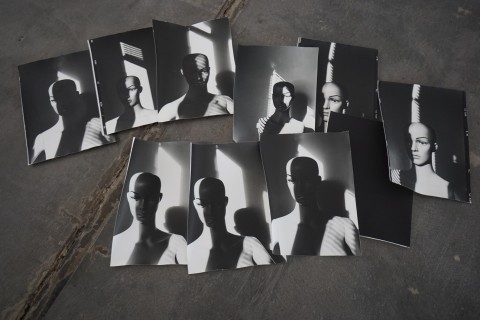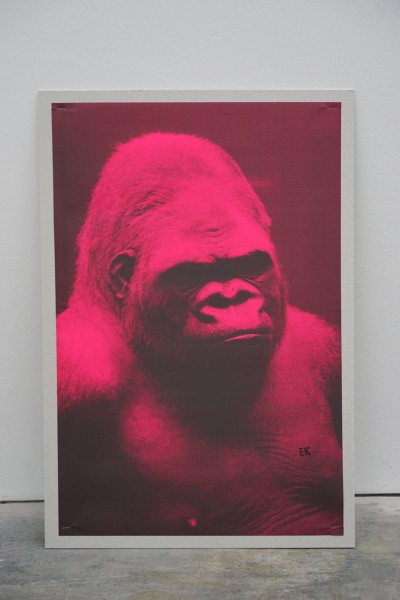Erwin Kneihsl that's it
Galerie Guido W. Baudach is pleased to present the eighth solo show of Erwin Kneihsl.
The artist originating from Vienna is known for his black and white photographies of selected subjects created with analog cameras. The images are transferred by hand deduction to Barite paper and are presented in an innovative, often spatially based way.
For the decidedly titled show that´s it Kneihsl transformed the exhibition space of the gallery by means of various fittings to an enclosed but at the same time transparent sphere. The photographies are not attached to the walls in a classic way but distributed well-aimed on the floor like autumn leaves in a Japanese garden. Outside and inside converge. Seemingly the garden is transplanted into an interior that brides with withdrawn as well as clear coordinates. To the objectified atmosphere especially contributes the even and dimmed scattered interior light. Entrance and closure of the exhibition space as well as a window placed laterally in the wall are provided with milky white shoji paper, an intervention that transmits the shaded atmosphere of the photographies to the perception of the space.
The presentation of the photographic works on the gallery floor may evoke the impression of a deliberate devaluation. However, more actual is a challenge that takes place to the visitors viewing practices. In general the exhibition follows its very own idea of aesthetic perfection by emphasizing the not symmetrical, the not yet finished and the irritating thing. Kneihsl realizes this basic idea also with the selection of his picture motives. While predominantly photographs of the sun are to be seen, the prototypical origin of all light, as well as differently illuminated portraits of a seemingly androgynous display dummy, other subjects differing from this iconography can be found here and there – for instance a photography where we see Kneihsl himself behind his camera.
The inclusion of the author but also the depiction of the light source reminds of pictorial creations turning up in Flemish painting of the 17th century. Especially in Jan Vermeer´s interiors windows appear as concrete sources of light whose radiation is modelling the figurations in the paintings in a complex way – similarily, Kneihsl directs the face of the dummy by side light and by backward light. At the same time considerations on photo theory come into play since the skin surface of the dummy shows exactly the same degree of reflection as the Gray Card, an indispensable photometric aid for the photographer.
Display dummies and suns are popular topoi of Classical Modernism. The first is connected to Neue Sachlichkeit (New Objectivity) and Surrealism, the second has its place inter alia in the Russian Avant-Garde, by name in the context of Constructivism. In Kneihsls pictorial cosmos both have been around as central motifs for quite some time. By continuous practice and repetition the artist follows a programmatic approach that expresses itself by more and more elaborate versions of the same theme. This constant exploration leads to the fact that through ever new light and shadow stagings the stereotypical three-dimensional figure of the dummy appears in a variety of ways and thereby seems strangely alive. At the same time the tension between individualized physicality and objectified artificiality lends the photographies a futuristic moment that makes one think of human cyborgs.
From the sea of leaves a larger, framed dummy image protrudes. It is juxtaposed with a photo of a gorilla printed on magenta red paper. Both are created with a digital camera and executed as computer generated prints which make them appear as a deliberate extension of Kneihsls usually analog way of working. The photo of the monkey shows an animal preparation from a Museum of Natural History that as well as the image of the dummy can be understood as an anthropological metaphor. However, it does not refer to the future but to the past, to the evolutionary history of man. Which when placed together, the two photographs form an imaginary timeline.
With that´s it Erwin Kneihsl combines selected aspects of Western art history with aesthetic concepts of Japanese culture and creates thereby on the basis of his own decades of practice in his medium a new, different manifestation of photography.
Thomas Groetz
Erwin Kneihsl has participated in numerous solo and group shows at home and abroad. Selected exhibitions from the last fifteen years include:
In medias res, Hiromi Yoshii Gallery, Tokyo (2018) / nightsun, Koya-san, Japan (2017) / Der rote Affe, The View, Budapest (2017) / Universe, Warsaw Gallery Weekend, Warschau (2014) / Prague Biennale 6 (2013) / US, Fabrik K, St. Gallen (2012) / Es gibt … / There is …, b-05 Kunst- und Kulturzentrum Association e.V, Montabaur (2012) / Die Andere Seite, KAI 10 | Arthena Foundation, Düsseldorf (2009) / BERLIN2000, PaceWildenstein, New York (2009) / Mare Humorum 1, Hiromi Yoshii Gallery, Tokyo (2008) / La Petite Histoire, Kunstraum Niederösterreich, Vienna (2008) / Kommando Calvin Cohn, Salon 94, New York (2007) / Constructing New Berlin, Phoenix Art Museum and Bass Museum of Art, Miami (2006) / Ketzer & Co. – Montage auf der Achse Brünn – Berlin, Haus der Kunst, Brünn (2006) / Schwarz, Brot, Gold, Oldenburger Kunstverein (2005) / Licht 4 - Der Heilige Berg, allerArt, Bludenz (2004) / Sex, Essen und Gewalt – Teil 1-3 (Ausschnitt), Werkblock 1984-93, Le Bar du Paris Bar, Berlin (2004) / Montana Sacra (Circles 5), ZKM, Karlsruhe (2001). Erwin Kneihsl edits Schönheit und Vernunft - Zeitschrift für Fototheorie, a journal published by Ich & Du. Erwin Kneihsl (b. 1952) lives and works in Vienna.
Die Galerie Guido W. Baudach freut sich, ihre achte Einzelausstellung von Erwin Kneihsl zu präsentieren.
Der aus Wien stammende Künstler ist bekannt für seine mit analogen Kameras erstellten und per Handabzug auf Barytpapier übertragenen Schwarzweißfotografien
ausgewählter Sujets, sowie für deren innovative, oft raumbezogene Präsentation.
Für die mit einem entschiedenen that’s it betitelte Show hat Kneihsl die Ausstellungsfläche der Galerie mittels verschiedener Einbauten in eine abgeschlossene, doch zugleich transparente Raumsphäre verwandelt. Die Fotografien sind nicht in klassischer Manier an den Wänden befestigt, sondern wie Herbstlaub im japanischen Garten gezielt auf dem Boden verteilt. Außen und Innen konvergieren; der Garten ist gleichsam in ein Interieur verpflanzt, welches über ebenso zurückgenommene wie klare Koordinaten verfügt. Zu der objektivierten Atmosphäre trägt insbesondere das gleichmäßige, abgedämpfte Streulicht im Inneren bei. Eingang und Abschluss des Ausstellungsbereiches, sowie ein seitlich in die Wand eingebrachtes Fenster sind mit milchig-weißem Shoji-Papier versehen, eine Intervention, welche die abgeschattete Stimmung in den Fotografien auf die Raumwahrnehmung überträgt.
Die Präsentation der fotografischen Arbeiten auf dem Galeriefußboden mag den Eindruck von bewusster Entwertung hervorrufen. Tatsächlich findet jedoch eine Aktivierung des in seinen Sehgewohnheiten herausgeforderten Publikums statt. Überhaupt folgt die Ausstellung einer ganz eigenen Vorstellung von ästhetischer Perfektion, indem sie das Nicht-Symmetrische, das noch nicht ganz Fertige, das Irritierende betont. Kneihsl setzt diese Grundidee auch bei der Auswahl seiner Bildmotive um. Während vorwiegend Fotografien der Sonne, dem prototypischem Ursprung allen Lichts, sowie unterschiedlich ausgeleuchtete Porträtaufnahmen einer androgyn wirkenden Schaufensterpuppe zu sehen sind, finden sich hier und da auch einige von dieser Ikonographie abweichende Sujets – etwa ein Foto, auf dem Kneihsl selbst hinter der Kamera zu sehen ist.
Das Einbeziehen des Urhebers, aber auch die Darstellung der Lichtquelle erinnert an Bildschöpfungen, wie sie in der flämischen Malerei des 17. Jahrhunderts in Erscheinung getreten sind. Insbesondere in den Interieurs von Jan Vermeer tauchen Fenster als konkrete Leuchtmittel auf, deren Ausstrahlung die Figuren in den Bildern auf komplexe Weise modelliert – ähnlich setzt auch Kneihsl das Antlitz der Puppe mittels Seiten- und Rücklicht in Szene. Gleichzeitig kommen hier fototheoretische Überlegungen ins Spiel, weist die Oberfläche der Puppe doch den exakt gleichen Reflexionsgrad wie die Gray Card auf, ein dem Fotografen unentbehrliches Hilfsmittel zur Lichtmessung.
Puppe und Sonne sind beliebte Topoi der Klassischen Moderne. Erstere ist im Kontext der Neuen Sachlichkeit und des Surrealismus verortet; letztere hat unter anderem in der russischen Avantgarde, namentlich im Konstruktivismus ihren Platz. In Kneihsls Bildkosmos sind beide bereits seit geraumer Zeit als zentrale Motive anzutreffen. Mit der kontinuierlichen Einübung und Wiederholung folgt der Künstler einer Programmatik, die sich in immer weiter ausgearbeiteten Varianten ein und desselben Themas ausdrückt. Diese stete Durchdringung führt dazu, dass die eigentlich stereotype plastische Figur der Puppe durch immer neue Licht-Schatten-Inszenierungen in vielfältiger Art und Weise auftritt und dabei seltsam verlebendigt erscheint. Gleichzeitig verleiht das Spannungsfeld zwischen individualisierter Körperlichkeit und objektivierter Künstlichkeit den Aufnahmen ein futuristisches Moment, das an menschliche Cyborgs denken lässt.
Ein größeres, gerahmtes Puppen-Bild ragt aus dem Blättermeer heraus. Ihm ist ein auf magentarotem Papier gedrucktes Foto eines Gorillas gegenübergestellt. Beide wurden mit einer Digitalkamera erstellt und als computergenerierte Prints ausgeführt, was sie als bewusste Erweiterung der bei Kneihsl sonst üblichen analogen Arbeitsweise erscheinen lässt. Die Fotografie des Affen zeigt ein Präparat aus einem Naturkundemuseum und ist ebenso wie das Bildnis der Puppe als anthropologische Metapher zu verstehen. Allerdings verweist diese nicht auf die Zukunft, sondern auf die Vergangenheit, auf die Entwicklungsgeschichte des Menschen. Gemeinsam bilden die beiden Fotografien eine imaginäre Zeitachse.
Erwin Kneihsl verbindet in that’s it ausgewählte Aspekte der westlichen Kunstgeschichte mit ästhetischen Konzepten der japanischen Kultur und schafft dabei auf Grundlage seiner eigenen jahrzehntelangen Praxis im angestammten Medium eine neue, andere Erscheinungsform von Fotografie.
Thomas Groetz
Erwin Kneihsl hat an zahlreichen Einzel- und Gruppenausstellungen im In- und Ausland teilgenommen. Eine Auswahl der letzten fünfzehn Jahre umfasst: In medias res, Hiromi Yoshii Gallery, Tokio (2018) / nightsun, Koya-san, Japan (2017) / Der rote Affe, The View, Budapest (2017) / Universe, Warsaw Gallery Weekend, Warschau (2014) / Prague Biennale 6 (2013) / US, Fabrik K, St. Gallen (2012) / Es gibt … / There is …, b-05 Kunst- und Kulturzentrum Association e.V, Montabaur (2012) / Die Andere Seite, KAI 10 | Arthena Foundation, Düsseldorf (2009) / BERLIN2000, PaceWildenstein, New York (2009) / Mare Humorum 1, Hiromi Yoshii Gallery, Tokio (2008) / La Petite Histoire, Kunstraum Niederösterreich, Warschau (2008) / Kommando Calvin Cohn, Salon 94, New York (2007) / Constructing New Berlin, Phoenix Art Museum and Bass Museum of Art, Miami (2006) / Ketzer & Co. – Montage auf der Achse Brünn – Berlin, Haus der Kunst, Brünn (2006) / Schwarz, Brot, Gold, Oldenburger Kunstverein (2005) / Licht 4 - Der Heilige Berg, allerArt, Bludenz (2004) / Sex, Essen und Gewalt – Teil 1-3 (Ausschnitt), Werkblock 1984-93, Le Bar du Paris Bar, Berlin (2004) / Montana Sacra (Circles 5), ZKM, Karlsruhe (2001). Erwin Kneihsl ist Herausgeber der Zeitschrift Schönheit und Vernunft – Zeitschrift für Fototheorie, die im Verlag Ich & Du erscheint. Erwin Kneihsl (*1952) lebt und arbeitet in Wien.












